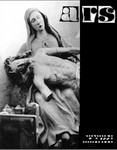
Časopis ARS 38 (2005) 2
Ivan GERÁT
Zápasy s anjelom – ikonologické poznámky k tradovaniu obrazových tém[Fighting with an Angel – Iconological Remarks in the Margin of Pictorial Traditions]
(Resumé)
The study is devoted to some problems of pictorial topics, which are similar or were at least in some respects related to each other.
Jacob’s fight with the angel, as depicted by Gauguin, provokes many questions. This theme, a traditional metaphor of a search for God, was not compatible with either naturalist or impressionist poetics. It was hardly an accident, that the painter abandoned those ways of seeing, thinking and painting just when he struggled with this biblical topic. Nevertheless, the painter‘s way out of the then dominating paradigms of pictorial thinking, opened by this image, did not lead further back to the biblical tradition, but basically behind the traditional questions, spaces and schemata of Judeo-Christian culture. His picture could not perform the traditional functions of a religious image within a Christian community. It was not presenting the story from the Old Testament within its traditional setting, as Delacroix, is spite of all his individualism, painted some decades earlier.
For the French culture of the 19th century, angels were no longer suitable for presentation of above-individual ideals. When solving similar pictorial tasks, e.g. celebrating a nationally important battle by a sculpted monument, the fighters were shown as inspired not by the angels, but by allegorical figures, which continued a visual tradition of antiquity without any explicit restoration of its religious messages.
Gauguin placed Jacob’s fight with the angel in the background of a composition, in which a conversation of rural women was depicted in the foreground. The latter could even be perceived as constitutive for the former. By this pictorial structure, the painter introduced some more fundamental questions, connected with the concept of popular superstition as used in the elitist critique of religion such as that of Friedrich Nietzsche. Nevertheless, an inspiration by Nietzsche could also lead to a different result: Hippolyte Delehaye was also a critically thinking elitist, but he was using all his forces to save the positive messages of mediaeval hagiography. Similar elitism might be criticized today, even by Jesuits, but it was also known to mediaeval legends: as an example of it, a passage from the classical biography of Saint Martin by Sulpicius Severus is quoted, where mighty armed angels helped the Saint in his fight against the temple, which had become rich owing to a popular superstition. Nevertheless, this important insight does not mean, that the fighting angels in mediaeval legends were carrying only spiritual messages: in the third part of the article, some examples from the lives of Saint Venceslas of Bohemia and Saint Ladislas of Hungary are discussed to illustrate some political instrumentalizations of the motif of the fighting angel in the mediaeval pictorial narrative.